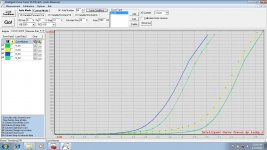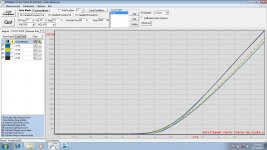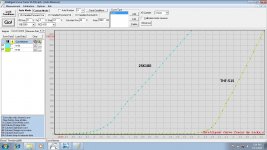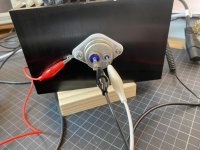From this amateur's point of view they look well matched.
That looks really good!

Great that’s well matched to me !
your post make me think if anyone has recommendation for the mica and bolts.
your post make me think if anyone has recommendation for the mica and bolts.
I bought two sets of roughly matched THF-51S from Japan and four 2SK180 from a different seller on Ebay.
Run them on the curve tracer and results are attached.
The last attachment shows one of each type for comparison. It shows totally different operating points from both devices.
Also my 2SK180 are different compared to one in Post #31
Tokin SIT low voltage high current curves
Is there any cause of concern with these findings?
Run them on the curve tracer and results are attached.
The last attachment shows one of each type for comparison. It shows totally different operating points from both devices.
Also my 2SK180 are different compared to one in Post #31
Tokin SIT low voltage high current curves
Is there any cause of concern with these findings?
Attachments
I have various SIT amps, a VFET preamp, and a SemiSouth amp and they all have unmatched output devices. Because of that their distortion profiles between channels vary. In my SemiSouth amp, one device has huge gate leakage current (greater than 0.5mA) so I had to adjust the circuit and operating point so that it is different from the other channel. Another amp, a 2SK180 follower has the same issue of high gate leakage current so it also operates at a different operating point for hours during warmup.
But whatever the differences caused by the unmatched devices, to my ears they all still sound great. Perhaps I am not discriminating enough. But too much information can negatively impact your enjoyment of the music. It gets into your head. I test and tweak, but I then let go and enjoy the music.
I say get whatever devices that are available and build an amplifier (or two or three) and enjoy their sound.😀
But whatever the differences caused by the unmatched devices, to my ears they all still sound great. Perhaps I am not discriminating enough. But too much information can negatively impact your enjoyment of the music. It gets into your head. I test and tweak, but I then let go and enjoy the music.
I say get whatever devices that are available and build an amplifier (or two or three) and enjoy their sound.😀
recommendation for the mica and bolts.
@ffarges
I have also been considering how to handle the thermal interface for these large electrically connected cases. I have been using Keratherm Kerafol for my builds. The sheets and some shapes are available in our neck of the woods at Conrad (as you probably already know). However I was intrigued by something a bit beefier for the Tokins and indulged in a few Al2O3 insulators from Canada. See attached.
The THF-51S starts to heat up once you get some current flowing >1.5?A. I used a fan on my test heatsink to keep the temperature in the thirties when over 1.8A. Being a €50 part and not easily obtainable I was being observant.
@ffarges
I have also been considering how to handle the thermal interface for these large electrically connected cases. I have been using Keratherm Kerafol for my builds. The sheets and some shapes are available in our neck of the woods at Conrad (as you probably already know). However I was intrigued by something a bit beefier for the Tokins and indulged in a few Al2O3 insulators from Canada. See attached.
The THF-51S starts to heat up once you get some current flowing >1.5?A. I used a fan on my test heatsink to keep the temperature in the thirties when over 1.8A. Being a €50 part and not easily obtainable I was being observant.
Attachments
I I test and tweak, but I then let go and enjoy the music.
I say get whatever devices that are available and build an amplifier (or two or three) and enjoy their sound.😀
Sage advice.

I have various SIT amps, a VFET preamp, and a SemiSouth amp and they all have unmatched output devices. Because of that their distortion profiles between channels vary. In my SemiSouth amp, one device has huge gate leakage current (greater than 0.5mA) so I had to adjust the circuit and operating point so that it is different from the other channel. Another amp, a 2SK180 follower has the same issue of high gate leakage current so it also operates at a different operating point for hours during warmup.
But whatever the differences caused by the unmatched devices, to my ears they all still sound great. Perhaps I am not discriminating enough. But too much information can negatively impact your enjoyment of the music. It gets into your head. I test and tweak, but I then let go and enjoy the music.
I say get whatever devices that are available and build an amplifier (or two or three) and enjoy their sound.😀
BM, I followed your build thread on 93V Choke Loaded 2SK180 L'Amp with great interest. I noticed the grid leakage issue in one of your 2SK180. I'm glad finally you sort out the instability issue in your amp. I will definitely enjoy the music once I build the first Vfet amp with these Tokin.
you're good
just pair them by curves and put in drawer till time to use them
ZM, they are waiting patiently for SissySIT R3 😀
With Al2O3 insulators you need to add some thermal paste to fill the non contact areas between heatsink, Al2O3 and THF51.@ffargesHowever I was intrigued by something a bit beefier for the Tokins and indulged in a few Al2O3 insulators from Canada.
Al2O3 insulators are very hard and don't bend,
but they are excellent at heat transfer.
Thanks for the advice. I will keep the thermal past in mind when I finally do install them on a proper heat sink in an amp circuit. The brittleness is a bit worrying but why not try it.
With Al2O3 insulators you need to add some thermal paste to fill the non contact areas between heatsink, Al2O3 and THF51.
Al2O3 insulators are very hard and don't bend,
but they are excellent at heat transfer.
I saw "ceramic insulators" and they were as white as depicted here. I thought they were ceramic like the tube sockets so forgot where. So from this post I infer there are aluminum oxide insulators that are flat (maybe a few holes on the whole, but paste fills the waste).
No no, impossible to cut or drill, they're too hard, you have to buy them in the correct size.
Maybe with an industrial water cooled diamond drill.
Maybe with an industrial water cooled diamond drill.
The Tokins are non-standard sizes so the pre-cut alumina sheets won’t work. So how do you make insulators for the tokins from these sheets?
Not.
You ask the manufacturer of those Al2O3 insulators if they can make them to your custom specs.
You ask the manufacturer of those Al2O3 insulators if they can make them to your custom specs.
Not.
You ask the manufacturer of those Al2O3 insulators if they can make them to your custom specs.
Thanks
Dremel and diamond bits?Maybe with an industrial water cooled diamond drill.
- Home
- Amplifiers
- Pass Labs
- While they last...



